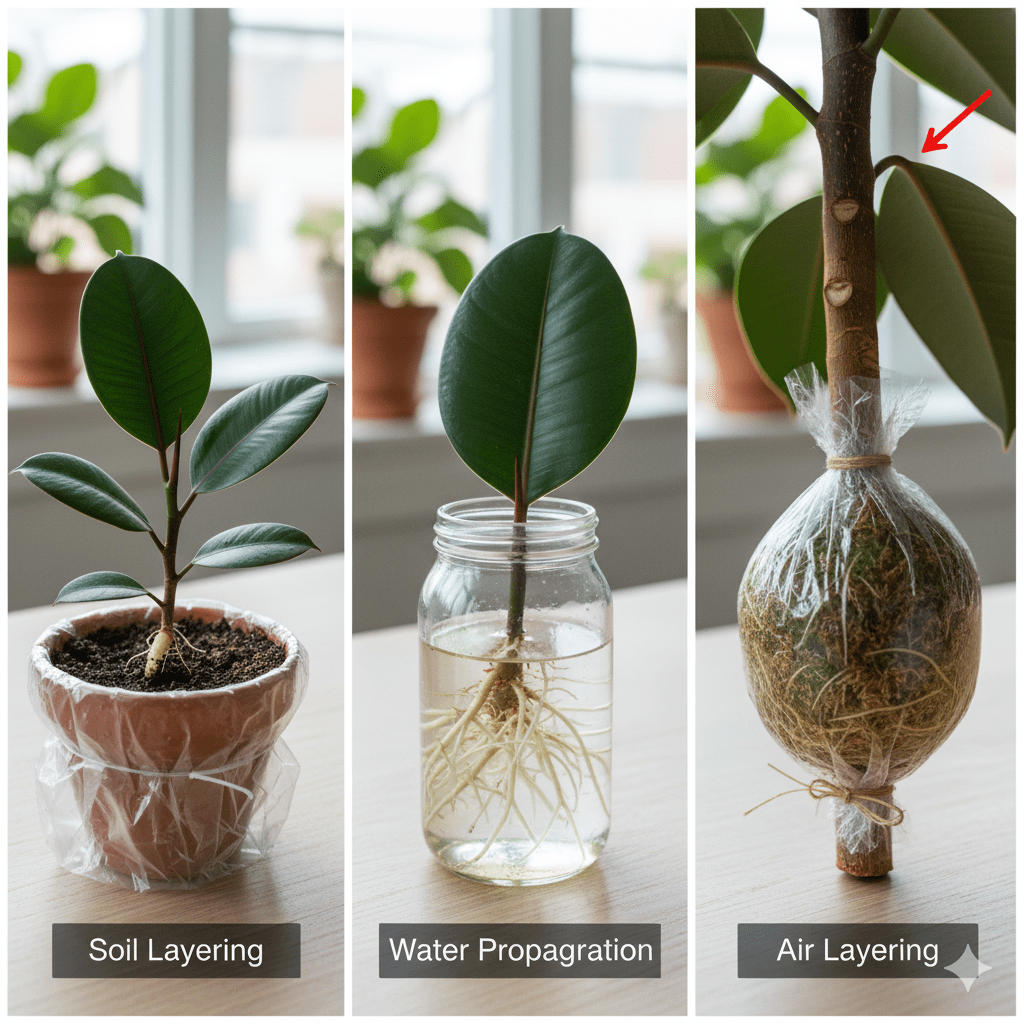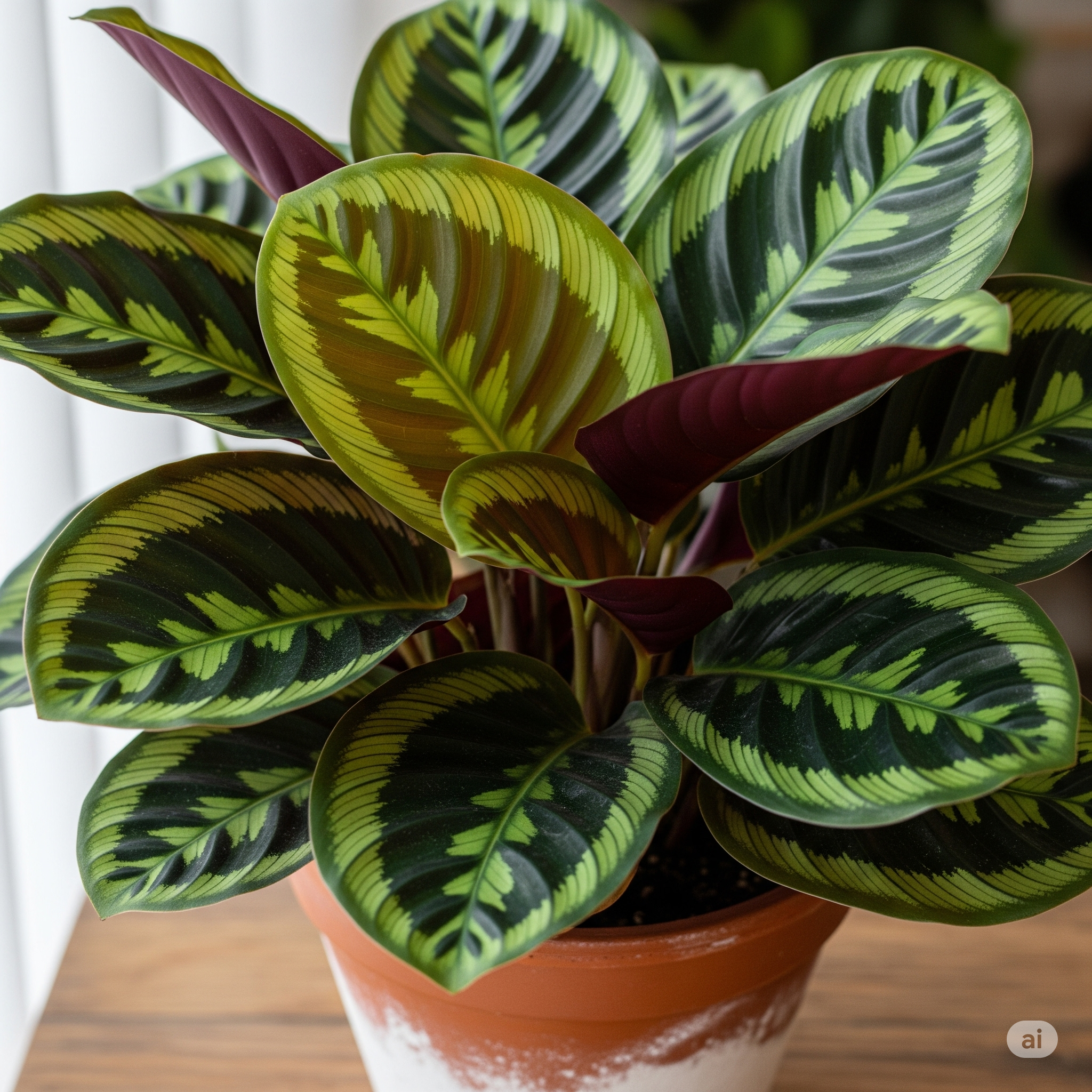Some links on this Website are affiliate links, meaning we may earn a commission if you make a purchase, at no additional cost to you. Please read our full Affiliate Disclosure for more details.
Rubber plants (Ficus elastica) are popular indoor trees known for their glossy leaves, upright growth, and ability to thrive with minimal care. But instead of buying more plants, you can easily propagate a rubber plant and grow new ones from your existing tree. This not only saves money but also allows you to share the beauty of this tropical plant with friends and family.

There are multiple techniques available for rubber plant propagation, but the three most reliable are stem cuttings in soil, stem cuttings in water, and air layering. Each approach has its own advantages depending on the size of your plant, your patience level, and whether you enjoy watching roots develop. By the end of this guide, you’ll know exactly how to propagate a rubber plant tree successfully.
Why Should You Propagate a Rubber Plant?
Learning how to propagate a rubber plant offers several benefits. Mature rubber plants often grow tall and leggy, losing their full, bushy shape. By pruning and using those cuttings for propagation, you encourage the parent plant to branch out and look healthier.
Propagation is also a cost-effective way to expand your plant collection. Rather than buying new ones, you can use rubber tree cuttings to grow multiple plants. Many plant lovers also use this opportunity to gift young rubber plants to friends. Beyond that, propagation helps rejuvenate an older plant while giving you insight into its natural growth cycle.
Top 6 Reasons Why Garden Plants Keep Dying
Methods To Propagate A Rubber Plant
Method 1: Rubber Plant Propagation in Soil
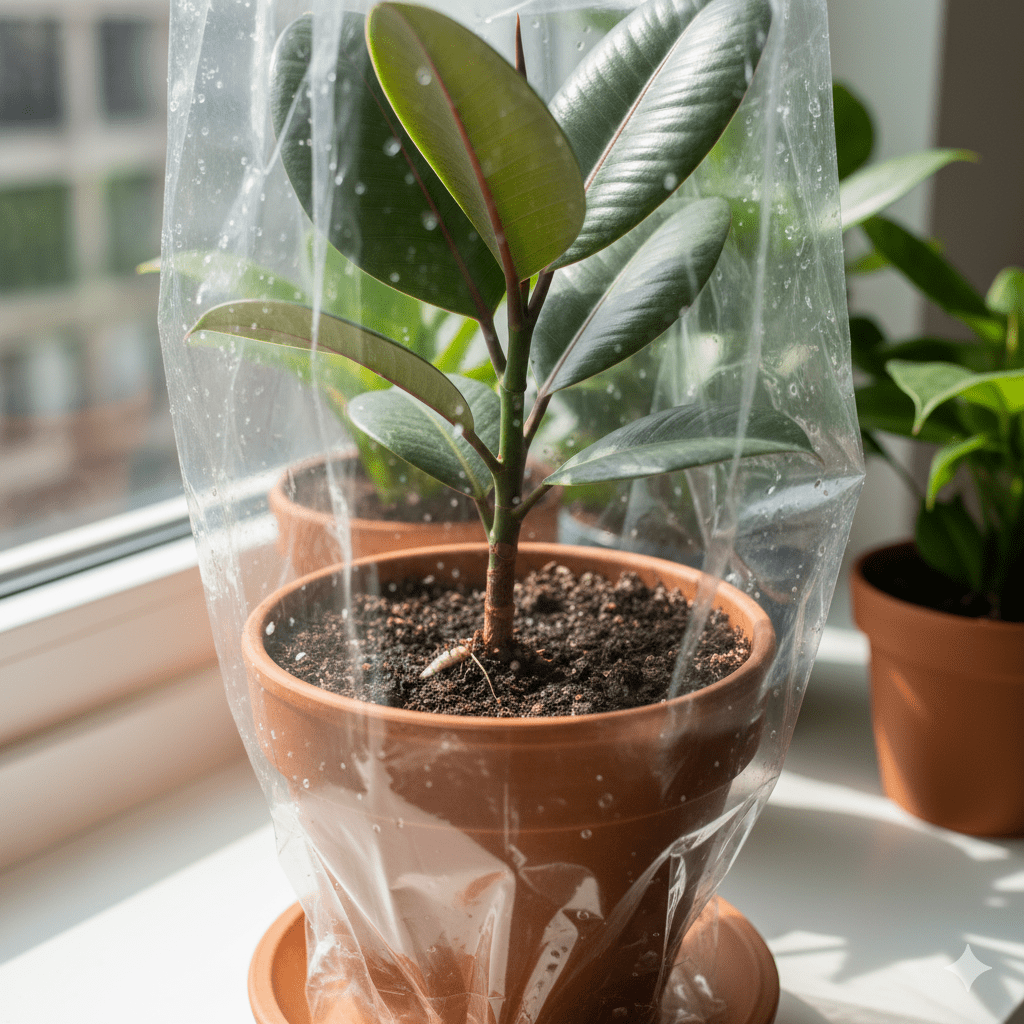
One of the most reliable techniques is rubber plant propagation in soil. This method is simple and works well even for beginners.
Start by selecting a healthy stem with at least one or two mature leaves and a visible node. Using sterilized pruning shears, cut a section 4–6 inches long just below a node. Remove the lower leaf so that the base of the cutting is bare, while leaving one or two leaves at the top to keep the plant photosynthesizing.
To encourage faster rooting, dip the cut end in rooting hormone. Next, place the cutting into a small pot filled with well-draining potting mix. Water lightly so the soil is moist but not soggy. Covering the pot with a clear plastic bag helps maintain humidity, creating a mini greenhouse effect that encourages root development.
Place the pot in bright, indirect light and check the soil regularly. Within 4–6 weeks, new roots should begin forming. You can confirm this by gently tugging on the cutting. If you feel resistance, the roots have established. At that point, your new plant can be transplanted into a larger container.
Method 2: Propagating Rubber Plant in Water
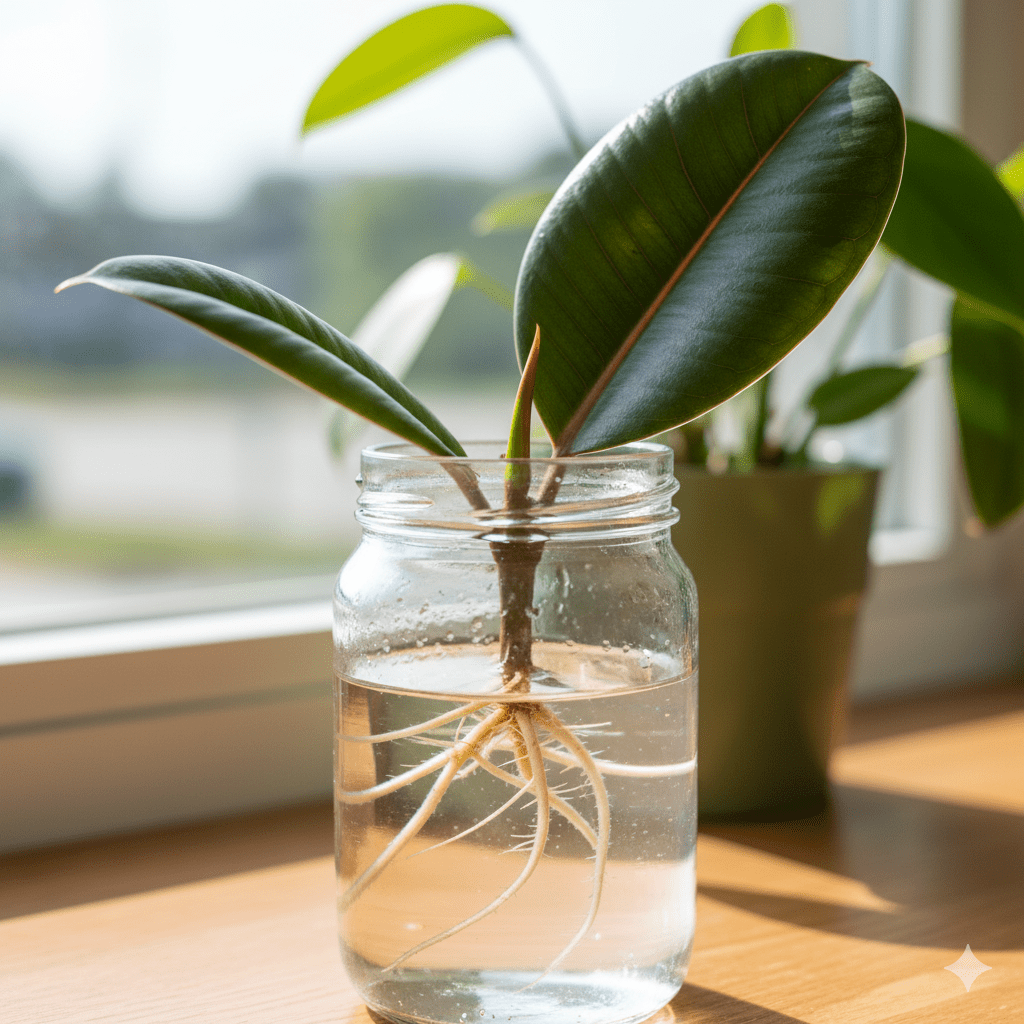
Another simple method is propagating a rubber plant in water, which allows you to monitor root growth closely. Many gardeners enjoy this technique because it’s rewarding to watch roots develop before transplanting.
Prepare the cutting the same way you would for soil propagation: choose a 4–6 inch stem with a healthy leaf and node. Instead of placing it in soil, submerge the cut end in a clean glass of water, making sure the node is underwater while the leaves remain above.
Keep the glass in a warm location with bright, indirect sunlight. Change the water every few days to prevent bacteria or algae buildup, which could cause the cutting to rot. Over several weeks, roots will begin emerging from the submerged node.
Once the roots are at least two inches long, you can carefully move the cutting into potting soil. While this transition can stress the plant briefly, it will quickly adapt if given proper watering and humidity. This method is particularly helpful for beginners who want to see exactly how rubber tree cuttings develop into new plants.
What Is The Best Way To Water A Pothos Plant?
Method 3: Rubber Plant Air Layering Method
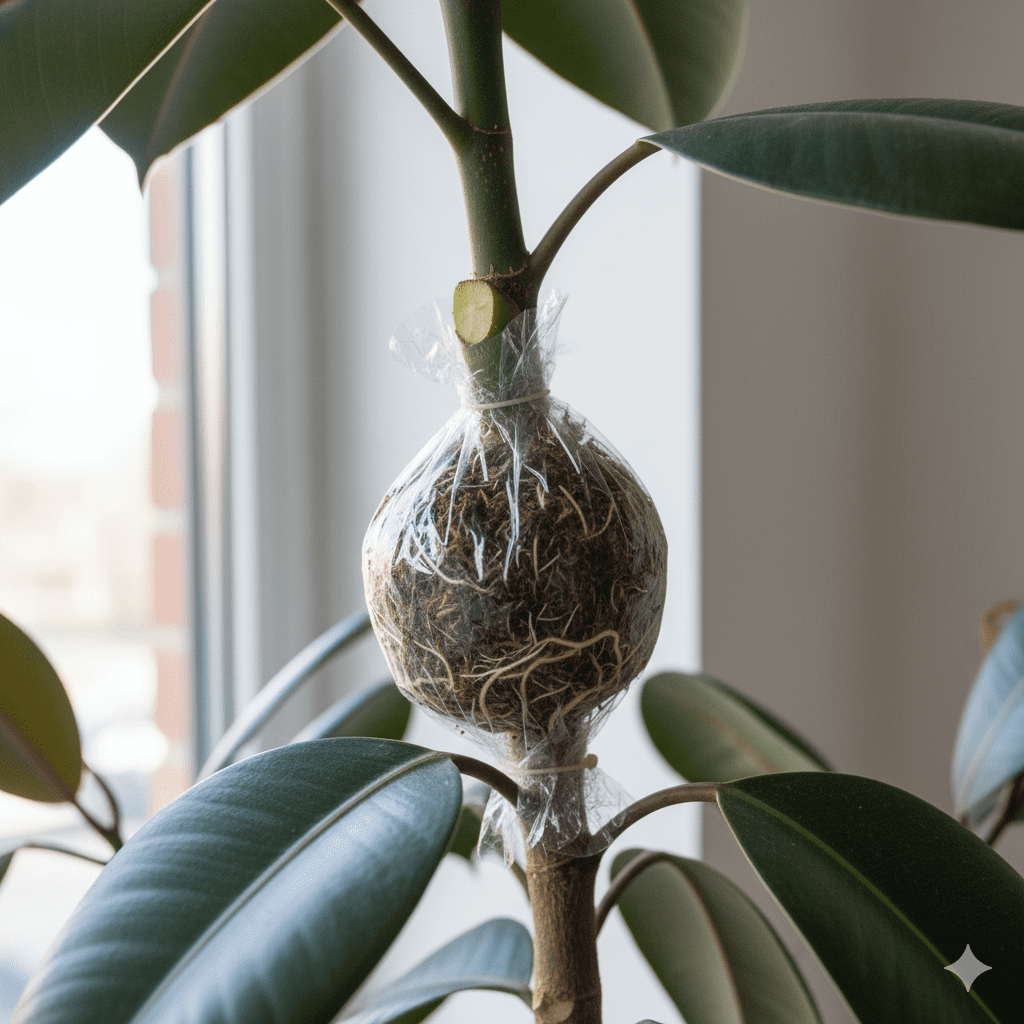
For larger or more mature plants, the rubber plant air layering method is the most effective. Unlike cuttings, this technique encourages roots to form on a stem while it’s still attached to the mother plant, ensuring stability and higher success rates.
Choose a healthy section of the stem, ideally around 12 inches below the top leaves. Make a small upward cut into the stem, about one-third of the way through. Insert a toothpick into the cut to keep it open. Then, wrap moist sphagnum moss around the cut area and cover it with clear plastic wrap, securing it with ties or tape.
Check the moss weekly to make sure it stays moist. After 6–8 weeks, you should see roots growing through the moss. Once the roots are well developed, cut below the rooted section and pot it in soil.
This method takes longer, but it’s one of the most reliable ways to propagate a rubber plant tree, especially if you’re dealing with a tall, woody specimen that doesn’t respond well to small cuttings.
Can You Transplant Succulents From Soil To Water?
Tips for How to Grow Rubber Plant from Cuttings
Regardless of whether you choose soil propagation, water propagation, or air layering, there are some universal tips for success:
- Sterilize your tools: Always cut with clean, sharp shears to prevent infections.
- Maintain humidity: Rubber plants root best in humid environments, so mist regularly or use plastic coverings.
- Provide indirect light: Bright but filtered sunlight is ideal for young cuttings.
- Be patient: Propagation can take weeks or months—slow progress is completely normal.
If you follow these steps, you’ll quickly master how to grow rubber plant from cuttings and enjoy thriving new plants in your collection.
Conclusion
Knowing how to propagate a rubber plant tree gives you the opportunity to grow new plants without spending extra money. The soil method is reliable and easy for beginners, water propagation lets you observe roots forming up close, and the air layering method works best for larger plants with woody stems.
Whichever method you choose, the key is patience and consistency. With time, care, and the right conditions, your cuttings will develop into healthy, vibrant rubber plants that can live for decades. Propagation not only multiplies your collection but also deepens your connection with the plant itself, making the experience truly rewarding.
Frequently Asked Questions
1. Can you propagate a rubber plant from just a leaf?
No, you cannot successfully propagate a rubber plant from a single leaf alone. While a leaf may stay green for a while in water or soil, it won’t develop into a new plant because it lacks a node. Nodes are essential since they contain the tissue needed for new roots and stems to grow. To propagate successfully, always include at least one node in your cutting.
2. How long does it take for rubber tree cuttings to root?
The rooting process varies depending on the method used. For rubber plant propagation in soil or water, it usually takes 4–8 weeks for roots to form. Air layering may take a little longer, often 6–10 weeks, but it generally produces stronger, more established roots before transplanting.
3. Is water or soil better for propagating rubber plant cuttings?
Both methods can be successful, but they offer different advantages. Propagating rubber plant in water lets you see the root development clearly, which is encouraging for beginners. However, moving from water to soil can sometimes shock the plant. On the other hand, rubber plant propagation in soil helps the cutting adjust to its permanent environment immediately, reducing transplant stress.
4. Can you propagate a rubber plant any time of year?
Technically, propagation can be done year-round indoors, but the best time is during the plant’s active growing season: spring and summer. During this period, the plant produces new growth more rapidly, making it easier to grow rubber plant from cuttings successfully.
5. Do I need rooting hormone to propagate a rubber plant?
Rooting hormone is not absolutely necessary, but it can significantly increase success rates, especially for rubber tree cuttings placed in soil. It encourages faster and stronger root development, reducing the time it takes for your cutting to establish.
